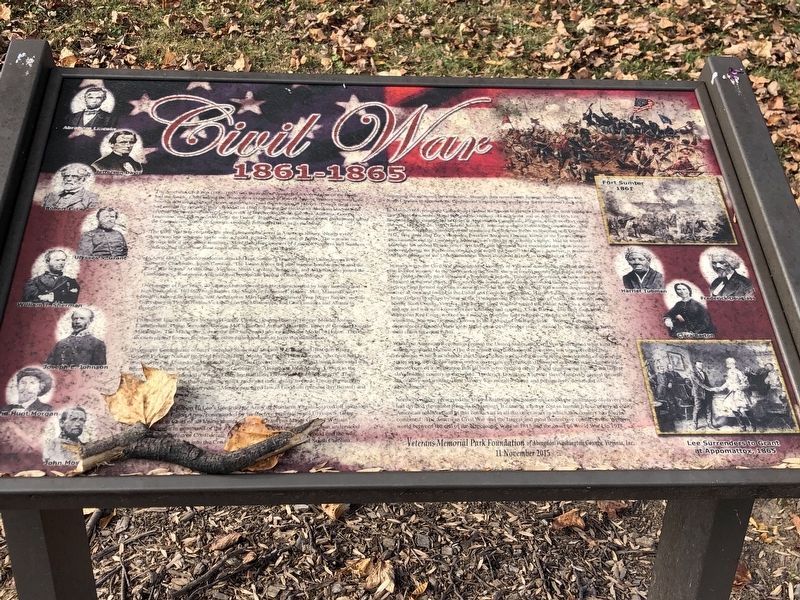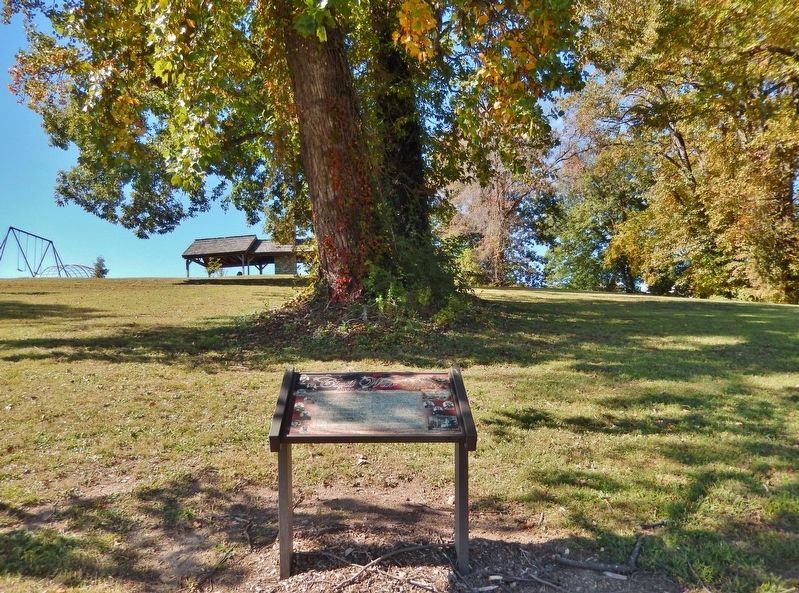Abingdon in Washington County, Virginia — The American South (Mid-Atlantic)
Civil War
1861-1865
The Civil War was certainly the most catastrophic event in American history. Nearly every American lost someone in the war: a friend, relative, brother, son, or father. The war was so divisive that it split many families. More than three quarters of a million Northern and Southern soldiers died in the war from small arms, artillery fire and disease.
In April 1861, Confederate forces attacked Fort Sumter, a key fort held by Union troops in the harbor of Charleston, South Carolina. The Union forces fell after intense bombardment and the Civil War began. At this time, Virginia, North Carolina, Tennessee, and Arkansas also joined the Confederacy. Richmond, Virginia then became the capital of the Confederacy.
Over a span of four years, 237 named battles were fought, characterized by bitter intensity and high casualties. In 1862, huge battles like Shiloh in Tennessee; Gaines' Mill, Manassas and Fredericksburg, Virginia, and Antietam in Maryland foreshadowed even bigger battles, such as Gettysburg in Pennsylvania, Vicksburg on the Mississippi, and Chickamauga and Atlanta in Georgia.
Prominent Union officers included George Custer, George Thomas, George Meade, Joshua Chamberlain, Philip Sheridan, George McClellan and Arthur Macarthur, father of General Douglas Macarthur. The Macarthurs were the first father and son awarded the Medal of Honor. Theodore Roosevelt and his son are the only other father and son to have this distinction.
Prominent Confederate officers included Stonewall Jackson, J.E.B. Stuart, Braxton Bragg, George Pickett, Nathan Bedford Forrest, john Mosby and John Hunt Morgan, who once had his headquarters in Abingdon. Morgan was killed in Greenville, Tennessee by Union forces and was interred for a time in the Sinking Spring Cemetery in Abingdon. John Mosby, known as the “Gray Ghost,” commanded a Virginia cavalry battalion known as Mosby's Rangers. These [obscured] were noted for their lightning quick raids and their ability to elude Union pursuers by [obscured] the countryside. Mosby practiced law in Goodson (present-day Bristol) and [obscured] war.
[Obscured] Robert E. Lee's Confederate Army of Northern Virginia staved off invasion [obscured] Union Army commanded by by ineffective generals until Ulysses S. Grant [obscured] in Chief of all Union armies. [obscured] Grant put Major General William T. Sherman in command of the [obscured]. Grant and Sherman understood [obscured] South Carolina, destroying the economic infrastructure. Sherman then turned north through South Carolina and North Carolina to approach the Confederate Virginia lines, increasing the pressure on Lee's army.
In March, 1865, retreating Confederates burned Richmond to prevent Union troops from taking the city. Grant then cornered and defeated the remains of Lee's army, and on April 9, 1865, Lee unconditionally surrendered to Grant at Appomattox Courthouse, Virginia, which in effect ended the war. On April 26, 1865, General Joseph E. Johnson, a senior Confederate commander who grew up in Abingdon, surrendered the remaining Confederate forces to Sherman near Durham, N.C. Five days after Lee's surrender, President Abraham Lincoln, author of the Emancipation Proclamation and the Gettysburg Address, was killed by an assassin's bullet. Had he lived to complete his second term in office, it is likely that he would have moderated the harsh policies imposed during the Reconstruction Era that roiled the South. His legacy, however, is preserved in the later passage of the 13th Amendment which abolished slavery in December of 1865.
In many ways, the Civil War challenged the ideology of Victorian domesticity that had defined the lives of women. In the North and in the South, the war forced women into public life in ways they could scarcely have imagined a generation before. Thousands of women on both sides were engaged in the war effort. They worked as nurses, spies, cooks, provided laundry and seamstress services and formed societies to raise money for the war. More than 400 women disguised themselves as men and fought in the Union and Confederate armies. Harriet Tubman, an escaped slave, helped others to escape by way of the “Underground Railroad,” a part of which ran through neighboring Scott County, Virginia. During the Civil War she served the Union army as a nurse, scout, and spy and was well-known for her kindness and courage. Clara Barton, who later founded the American Red Cross, worked as a nurse in frontline field hospitals, tending to the sick and wounded. She was famously known as the “Angel of the Battlefield”. Women's wartime experiences expanded their ideas about what their “proper place” should be and would help further their claim for equal rights.
While the American Revolution created the United States, the Civil War determined what kind of nation we would become. The war settled two fundamental questions left unresolved by the Revolution. One was whether the United States was to be a dissolvable confederation of sovereign states or an indivisible nation with a sovereign government. The other question was whether this nation, born of a declaration that all men were created equal, would continue to exist as the largest slaveholding country in the world. Frederick Douglass, a former slave, famously argued through his oratory and writings that slavery was morally wrong and persuasively demanded its abolishment.
Northern victory preserved the United States as one nation and ended the institution of slavery that had divided the nation from its beginning. It came at a heavy cost in human lives: Nearly as many American soldiers died in this conflict as in all the other wars in which this country has fought combined. The American Civil War was the largest and most destructive conflict in the Western world between the end of the Napoleonic Wars in 1815 and the onset of World War I in 1914.
Erected 2015 by Veterans Park Memorial Foundation.
Topics. This historical marker is listed in these topic lists: Abolition & Underground RR • African Americans • War, US Civil • Women. A significant historical month for this entry is April 1861.
Location. 36° 42.304′ N, 81° 58.524′ W. Marker is in Abingdon, Virginia, in Washington County. Marker can be reached from Lt Billy Webb Avenue, 0.1 miles north of Cook Street. Marker is in Veterans Memorial Park. Touch for map. Marker is at or near this postal address: 425 Lt Billy Webb Ave, Abingdon VA 24210, United States of America. Touch for directions.
Other nearby markers. At least 8 other markers are within walking distance of this marker. Medal of Honor (a few steps from this marker); U.S.-Mexican War (a few steps from this marker); Star-Spangled Banner (within shouting distance of this marker); War of 1812 (within shouting distance of this marker); Lewis & Clark Expedition (within shouting distance of this marker); World War I (within shouting distance of this marker); History of Veterans Day (within shouting distance of this marker); Purple Heart (within shouting distance of this marker). Touch for a list and map of all markers in Abingdon.
Credits. This page was last revised on February 2, 2023. It was originally submitted on November 10, 2022, by Duane and Tracy Marsteller of Murfreesboro, Tennessee. This page has been viewed 175 times since then and 19 times this year. Photos: 1. submitted on November 10, 2022, by Duane and Tracy Marsteller of Murfreesboro, Tennessee. 2. submitted on November 14, 2022, by Cosmos Mariner of Cape Canaveral, Florida.
Editor’s want-list for this marker. Complete inscription on the marker • Can you help?

